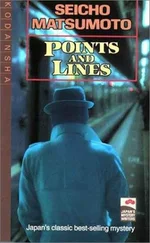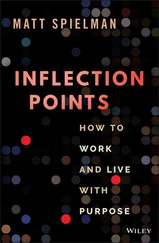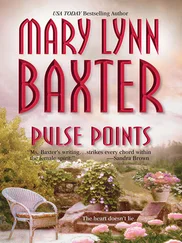Shortly thereafter, Jim Baker called to ask if I wanted to appeal to the U.S. Supreme Court. He and Ted Olson, an outstanding lawyer Jim had recruited, felt we had a strong case. They explained that appealing the decision was a risky move. The U.S. Supreme Court might not agree to hear the case, or they could rule against us. I told Jim to make the appeal. I was prepared to accept my fate. The country needed closure, one way or the other.
On December 12, thirty-five days after the election, Laura and I were lying in bed when Karl called and insisted that we turn on the TV. I listened intently as Pete Williams of NBC News deciphered the Supreme Court’s verdict. By a vote of 7–2, the justices found that Florida’s chaotic, inconsistent recount procedure had violated the equal protection clause of the Constitution. Then, by a vote of 5–4, the Court ruled that there was no fair way to recount the votes in time for Florida to participate in the Electoral College. The election results would stand. By a tally of 2,912,790 to 2,912,253, I had won Florida. I would be the forty-third president of the United States.
My first response was relief. The uncertainty had inflicted a heavy toll on the country. After all the ups and downs, I didn’t have the emotional capacity to rejoice. I had hoped to share my victory with twenty thousand people at the state capitol on election night. Instead, I probably became the first person to learn he had won the presidency while lying in bed with his wife watching TV.

For the first 140 years of American history, presidential inaugurations were held on March 4. A president elected in early November had about 120 days to prepare for his administration. In 1933, the Twentieth Amendment changed Inauguration Day to January 20, shortening the average transition to about 75 days. When the 2000 election was finally resolved in Bush v. Gore , I had 38 days.
My first big decision was how I wanted the White House to function. That was a question I had pondered before. In 1991, Dad asked me to study the operation of his White House. After interviewing all his senior staffers, a common theme emerged: People were dissatisfied. Most felt that Chief of Staff John Sununu had denied them access to the Oval Office and limited the flow of information to Dad. I had always liked John, but my job was not to debate the case; it was to report the findings. I did so several days before Thanksgiving of 1991. Dad concluded that he needed to make a change. He asked me to notify John, which I did in an awkward conversation. He submitted his resignation shortly thereafter.
I was determined to avoid that problem in my White House. I wanted a structure that was tight enough to ensure an orderly flow of information but flexible enough that I could receive advice from a variety of sources. It was important that advisers felt free to express concerns to me directly, without passing through a filter. Plus it would be easier to convince key members of my Texas political family to move to Washington if they would have regular access to me.
The key to creating this structure was to hire an experienced, confident chief of staff who would not feel threatened by my relationships with his subordinates. Ironically, I found the perfect man in John Sununu’s deputy, Andy Card. When I visited Dad’s White House, I would often kick back in Andy’s office to get a candid update on how things were going. Andy was perceptive, humble, loyal, and hardworking. He had served under every chief of staff during both the Reagan and Bush presidencies. He had the sound judgment and steady temperament I needed, along with a caring heart and a good sense of humor. I was convinced he was the right person to lead my White House staff.
A couple of weeks before the election, I met discreetly with Andy in Florida. It was clear he thought I was asking him to lead the transition. “No, I’m talking about The Big One,” I said. I explained that he would be the only chief of staff, but that I would also rely heavily on Texans like Karl, Karen, Al Gonzales, Harriet Miers, Clay Johnson, and Dan Bartlett for advice. Andy agreed to the job, so long as I informed him of any decisions I made outside his presence. I announced his selection in late November, making him the first official member of my White House team.
The next important position to fill was national security adviser. I knew from watching Dad’s close relationship with Brent Scowcroft that it was crucial to find someone highly capable and completely trustworthy.
On a trip to Maine in the summer of 1998, Dad introduced me to Condoleezza Rice, who had served as a Soviet specialist on his National Security Council staff. The daughter of an African American minister from segregated Birmingham, Alabama, Condi had a Ph.D. from the University of Denver and had become provost of Stanford at age thirty-eight. She immediately struck me as a smart, thoughtful, energetic woman.
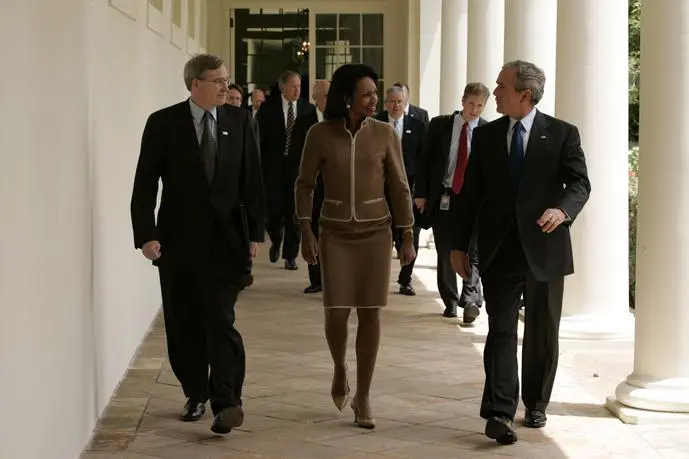
With my two closest foreign policy advisers, Steve Hadley and Condi Rice. White House/Paul Morse
Over the next two and a half years, Condi and I met frequently to discuss foreign policy. One summer day in 1999, Condi, Laura, and I were hiking on the ranch. As we started to climb up a steep grade, Condi launched into a discourse on the history of the Balkans. Laura and I were huffing and puffing. Condi kept going, explaining the disintegration of Yugoslavia and the rise of Milosevic. That trail is now known as Balkan Hill. I decided that if I ended up in the Oval Office, I wanted Condi Rice by my side.
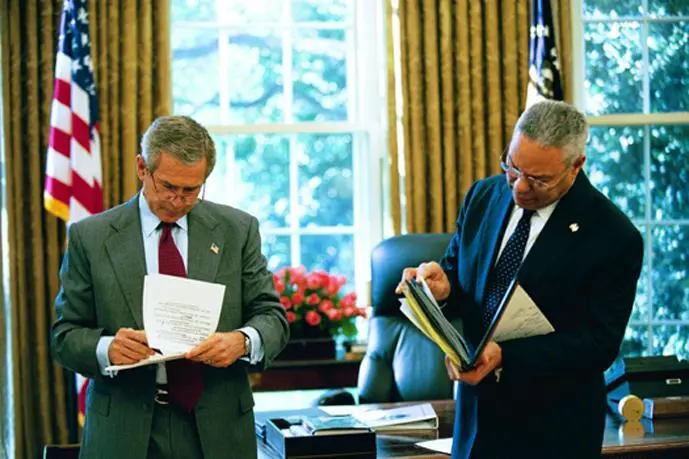
With Colin Powell. White House/Eric Draper
The first selection for the Cabinet was easy. Colin Powell would be secretary of state. I had first met Colin at Camp David in 1989, when he was chairman of the Joint Chiefs of Staff. He and Dick Cheney had come to brief Dad on the surrender of Panamanian dictator Manuel Noriega. Colin was wearing his Army uniform. In contrast to the formality of his dress, he was good-natured and friendly. He spoke to everyone in the room, even bystanders like the president’s children.
Colin was widely admired at home and had a huge presence around the world. He would credibly defend American interests and values, from a stronger NATO to freer trade. I believed Colin could be the second coming of George Marshall, a soldier turned statesman.
The two key national security positions left were secretary of defense and director of central intelligence. More than a decade after the Berlin Wall fell, much of the Defense Department was still designed for fighting the Cold War. I had campaigned on an ambitious vision to transform the military. I planned to realign our force structure and invest in new technologies such as precision weapons and missile defense. I knew there would be resistance within the Pentagon, and I needed a tenacious, innovative secretary to lead the effort.
My top candidate was Fred Smith, the founder and chief executive of FedEx. Fred graduated from Yale two years ahead of me, earned the Silver Star as a Marine in Vietnam, and built his company into one of the world’s most successful businesses. He loved the military and would bring an organizational mind to the Pentagon. Andy Card called Fred, learned he was interested in the job, and invited him to Austin. I was prepared to offer Fred the position, but before he made the trip, he was diagnosed with a heart condition. He had to bow out to focus on his health.
Читать дальше






